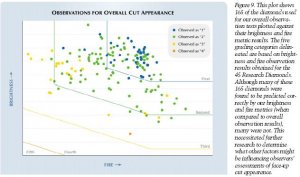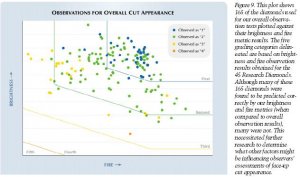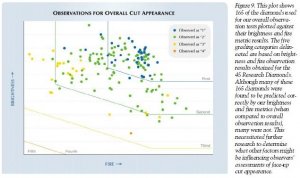adamasgem
Brilliant_Rock
- Joined
- May 23, 2003
- Messages
- 1,338
Date: 2/17/2006 7:45:50 AM
Author: Garry H (Cut Nut)
That is the point Marty - the whole point and nothing but the point.Date: 2/17/2006 5:11:47 AM
Author: adamasgem
if their final uniiform uniform (46/23) intensity dome is any examole, as I strongly believe the model they came up with does not accurately reflect the physical envirornment they tried to simulate and correlate with ''observations''.Date: 2/17/2006 1:57:58 AM
Author: Garry H (Cut Nut)
Marty they did lots of looking in domes that may have been somewhat related to computer models - but they did say that only 58%? of human observers in the light box matched those computer predictions.
They made a model because of their computer study to try to legitimize the money and decade they had wasted.
Look, in their defense, it was not entirely wasted, just the chunk that went to defray their management salaries.
They made a model that matched their lighting box DiamondDock CVE results, which had too much concentrated light coming from a narrow direction. I did a 18" fluorescent tube model using WLR and compared it with their original diffuse hemispher. I''ll have to did out that data and post it
The plastic salad bowl dome that matched this had a huge amount of obstruction darkness around the observer because in many rooms these 2 strong fluoro tubes and 12 LED intense spots (relative to often dull room lighting) made anything but steep deep proportioned stones look dead.
As I read their last article, I can''t see where they used their CVE model box in their final metric. As to the hemispheres, I do not believe the backlit hemispheres (Fig 7 of their 2004 model) result in uniform diffuse illumination emmenating from the white areas, as suggested in their (46/23) hemisphere model of table 5.
One would note also that the acrylic domes are transluscent (While some of the backsides appear to be paited black), and that the viewer shown in Figure 7 is using a transluscent dome. I wonder how they treated the direct light to the viewer''s eye (background evironment effecting pupil diameter) that would be much more intense than any light return from the diamond, as a guestimate. I''m going to try this out with a smaller dome and light box I have when I get the time and money to waste. First a litlle physical modeling is necessary.
They then took that model and showed that they could indeed make a computer model that had a 58% level of accuracy. Hello? Garbage model, Garbage result
They messed up in the human observer section.
But it will be good for business. But what if the world wakes up and realises that the worlds formeost authority either made a mistake or made a commercial decison? It is all about "shoot the engineer and get the product out the door"












300x240.png)